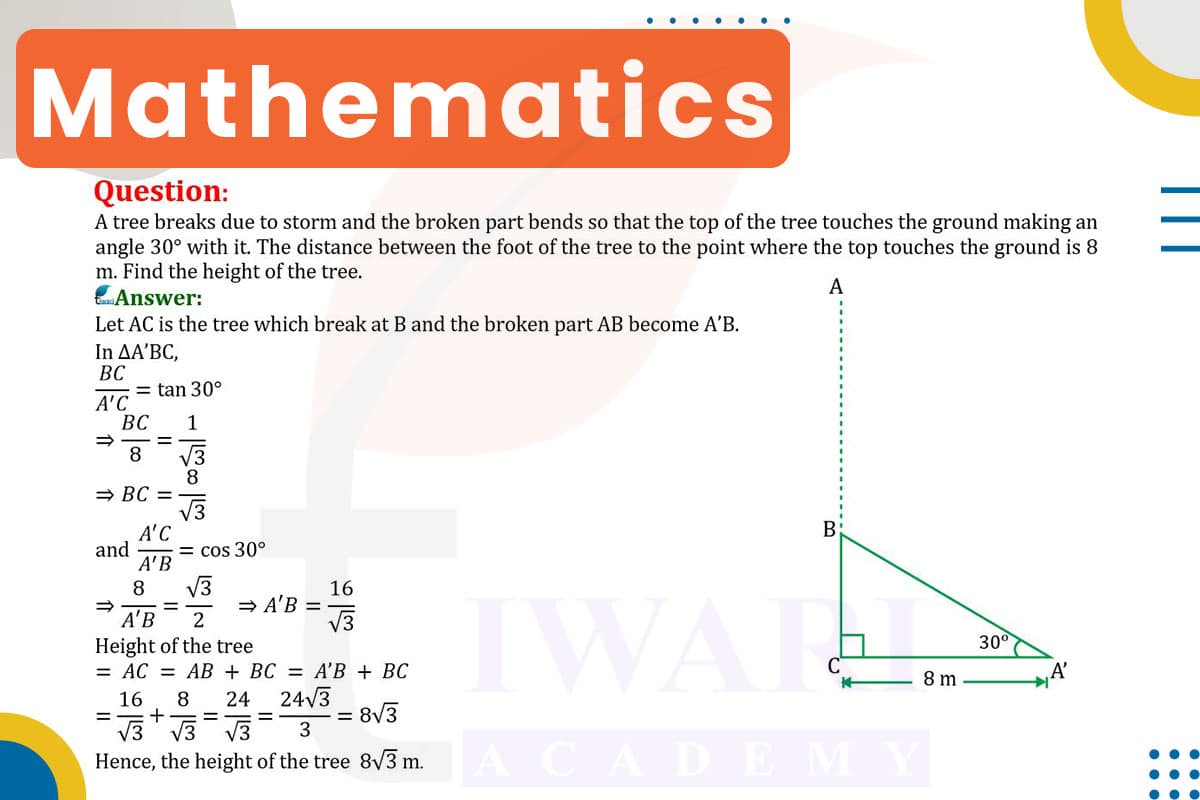In this question, a broken tree forms a right-angled triangle with the ground. The original height of the tree can be found using trigonometry. The distance from the tree’s base to the point where the top touches the ground (8 meters) is the adjacent side of the 30° angle, and the tree’s height is the opposite side.
In a right-angled triangle, the tangent of an angle is the ratio of the opposite side to the adjacent side. Therefore, tan(30°) = (height of the tree)/(8 m).
Given tan(30°) = 1/√3, the equation becomes 1/√3 = (height of the tree)/8.
Solving for the height, we get height of the tree = 8/√3, which simplifies to approximately 4.62 meters. Thus, the original height of the tree is about 4.62 meters.

Let’s discuss in detail
Introduction to Trigonometric Problem-Solving
Trigonometry, a fundamental branch of mathematics, is widely used to solve problems involving angles and distances. One common real-world application is in determining the heights of objects, such as trees, poles, or buildings, especially when direct measurement is impractical. The problem presented here involves a tree that has broken and fallen in such a way that it forms a specific angle with the ground. By applying trigonometric principles, we can calculate the original height of the tree. This scenario is an excellent example of how trigonometry can be applied in practical situations, particularly in dealing with the aftermath of natural events like storms.
Understanding the Broken Tree Scenario
In the given problem, a tree breaks during a storm and falls to the ground, forming a 30° angle at the point where the top of the tree touches the ground. The distance from the base of the tree to this point is 8 meters. This situation creates a right-angled triangle, with the tree itself representing one side (opposite to the angle), the distance from the tree’s base to the top as it lies on the ground (8 meters) as the adjacent side, and the original height of the tree as the unknown we seek to determine.
The Role of Tangent in Trigonometry
To solve this problem, we focus on the tangent function in trigonometry. The tangent of an angle in a right-angled triangle is the ratio of the length of the opposite side to the length of the adjacent side. In our scenario, the tangent function is ideal for finding the height of the tree, as we have the length of the side adjacent to the angle (8 meters) and need to find the length of the side opposite the angle (the tree’s height).
Applying the Tangent Function
Applying the tangent function to the 30° angle, we use the formula tan(30°) = opposite/adjacent. The tangent of 30° is a known value, 1/√3. Substituting the known values into the formula, we get 1/√3 = (height of the tree)/(8 m). This equation allows us to solve for the height of the tree.
Calculating the Height of the Tree
Rearranging the equation to isolate the height of the tree, we multiply both sides by 8 meters. This gives us height of the tree = 8m × 1/√3. Simplifying this equation, we find that the height of the tree is approximately 4.62 meters. This calculation demonstrates how trigonometry can be effectively used to solve problems involving angles and distances in real-world scenarios.
Trigonometry in Practical Applications
This example underscores the practicality of trigonometry in everyday life. The ability to calculate unknown dimensions using angles and distances is invaluable, not just in academic settings but also in real-life situations like assessing damage after natural disasters. Trigonometry bridges the gap between theoretical mathematics and practical applications, highlighting the importance of understanding mathematical concepts for solving real-world problems.
Discuss this question in detail or visit to Class 10 Maths Chapter 9 for all questions.
Questions of 10th Maths Exercise 9.1 in Detail


